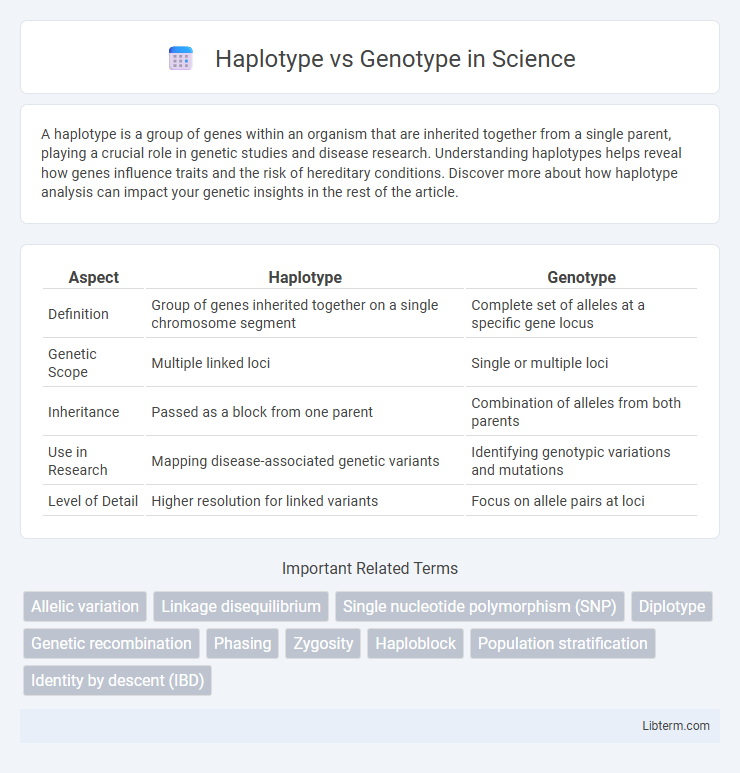A haplotype is a group of genes within an organism that are inherited together from a single parent, playing a crucial role in genetic studies and disease research. Understanding haplotypes helps reveal how genes influence traits and the risk of hereditary conditions. Discover more about how haplotype analysis can impact your genetic insights in the rest of the article.
Table of Comparison
| Aspect | Haplotype | Genotype |
|---|---|---|
| Definition | Group of genes inherited together on a single chromosome segment | Complete set of alleles at a specific gene locus |
| Genetic Scope | Multiple linked loci | Single or multiple loci |
| Inheritance | Passed as a block from one parent | Combination of alleles from both parents |
| Use in Research | Mapping disease-associated genetic variants | Identifying genotypic variations and mutations |
| Level of Detail | Higher resolution for linked variants | Focus on allele pairs at loci |
Introduction to Haplotypes and Genotypes
Haplotypes represent combinations of alleles at multiple loci that are inherited together on the same chromosome, providing insight into genetic linkage and ancestry. Genotypes refer to the specific allelic composition at one or more loci in an individual's DNA, reflecting their genetic makeup. Understanding haplotypes and genotypes is essential for studying genetic variation, disease associations, and population genetics.
Defining Genotype: The Basics
Genotype refers to the specific genetic makeup of an organism, representing the set of alleles inherited from both parents at particular gene loci. It determines the hereditary information that influences an organism's traits and is often analyzed using DNA sequencing or molecular markers. Understanding genotype is fundamental for studying inheritance patterns, genetic disorders, and variations within populations.
Understanding Haplotypes: Key Concepts
Haplotypes represent a group of alleles inherited together from a single parent, reflecting specific sequences of DNA variations across closely linked loci. Unlike genotypes, which denote the pair of alleles an individual possesses at a locus, haplotypes provide insight into the arrangement and combination of these variations along a chromosome. Understanding haplotypes is crucial for mapping genetic traits, studying population genetics, and identifying disease-associated gene variants.
Differences Between Haplotype and Genotype
Haplotype refers to a group of genes within an organism inherited together from a single parent, representing specific combinations of alleles at adjacent loci on a chromosome. In contrast, genotype describes the complete set of alleles for a particular gene or set of genes within an individual, encompassing both inherited copies from each parent. Unlike genotype, which analyzes individual gene variants, haplotype captures the arrangement and linkage of multiple genetic variants, providing more detailed insights into genetic inheritance and population genetics.
Biological Significance of Genotypes
Genotypes represent the complete set of alleles inherited from both parents, directly influencing an organism's phenotype and biological traits. Understanding genotypes enables researchers to predict hereditary disease risks, responses to environmental factors, and evolutionary adaptations. Unlike haplotypes, which are combinations of alleles at adjacent loci on a single chromosome, genotypes encompass the full genetic makeup across all loci, providing comprehensive insights into genetic variation and inheritance patterns.
The Role of Haplotypes in Genetic Diversity
Haplotypes represent a group of alleles inherited together from a single parent, capturing the combination of genetic variants across a chromosome, while genotypes refer to the specific pair of alleles at individual genetic loci. Haplotypes play a crucial role in genetic diversity by preserving the linkage of genetic variations, enabling the study of population structure, evolutionary history, and disease association with greater resolution. The analysis of haplotype blocks facilitates the identification of ancestral genetic patterns and improves the accuracy of genome-wide association studies (GWAS) through more informative markers than single-locus genotypes.
Methods for Identifying Haplotypes and Genotypes
Genotypes are identified using techniques such as PCR, DNA sequencing, and microarrays, which detect specific alleles at individual loci. Haplotypes are determined through methods like haplotype phasing, which uses computational algorithms to infer allele combinations on the same chromosome, or through long-read sequencing technologies that directly read contiguous DNA segments. Statistical approaches, including population-based phasing and linkage disequilibrium analysis, further refine haplotype identification by leveraging genetic variation patterns across multiple loci.
Applications in Medical and Genetic Research
Haplotypes provide critical insight into inherited genetic variations by analyzing combinations of alleles at adjacent loci, enabling more precise mapping of disease-associated genes in medical research. Genotype data offers information on individual genetic variants, facilitating personalized medicine approaches such as pharmacogenomics and risk assessment for complex diseases. Integrating haplotype and genotype analysis enhances understanding of population genetics, improves detection of linkage disequilibrium, and accelerates the development of targeted therapies.
Haplotype vs Genotype in Disease Association Studies
Haplotypes provide a more detailed genetic framework than genotypes by capturing the specific combination of alleles inherited together on a single chromosome, which enhances the resolution in disease association studies. While genotypes identify individual variants, haplotypes reveal linkage disequilibrium patterns that can improve the detection of genetic markers associated with complex diseases. Using haplotype analysis often increases the power to identify risk alleles and understand the genetic architecture underlying multifactorial diseases.
Future Perspectives in Haplotype and Genotype Analysis
Advancements in haplotype and genotype analysis are driving personalized medicine by enabling precise identification of genetic variations linked to diseases and drug responses. Emerging technologies like long-read sequencing and AI-powered algorithms enhance haplotype phasing accuracy, revealing complex genetic architectures previously inaccessible. Integration of multi-omics data with haplotype and genotype information promises breakthroughs in predictive genomics, facilitating tailored therapeutic strategies and improved health outcomes.
Haplotype Infographic

 libterm.com
libterm.com